When was it built : between 1632 and 1653 AD
Who built it : Shah Jahan, 5th Emperor of the Mughal Dynasty
Time taken : 21 years
Where is it located : Agra, Uttar Pradesh, India
Why was it built : As a memorial to Shah Jahan’s beloved wife Mumtaz Mahal after her death in 1631
Dimensions : situated in a 170000 sq. m complex; 57 m at the base; 68 m in height and raised platform height 6 m
Materials used : White Marble for the main mausoleum, Red Sandstone for fortifying structure and accents
Architect : Ustad Ahmed Lahori
Architectural Style : Mughal
Cost of Construction : 32 crore rupees
Maintained By : Archeological Survey of India (ASI)
Special Recognitions : Declared UNESCO World Heritage site in 1983 and winner of the New7Wonders of The World List Initiative between 2000 and 2007.
Visit Timing : Sunrise to Sunset; Closed on Fridays; Night tours are permitted between 8:30 pm to 12:30 am for a limited duration of 30 mins.
Entry Fee : By day, foreign citizens are charged Rs. 100, citizens from countries are charged Rs. 530, Indian citizens Rs. 40 and entry for children upto 15 yrs of age is free.
At night, entry fee for foreign, SAARC and BIMSTEC citizens remain same. Rs. 500 is charged for Indian citizens and children below the age of 3yrs have free entry.
How to Reach: Agra can be reached by air as well as land. The city has an airport, Kheria Air Force Station, which is catered by daily flights from all over India through multiple airlines. By land one can avail bus, train and private cars from the nearest metro cities like Delhi (176.7 km), Jaipur (219.7 km), and Lucknow (289.5 km). Within the Agra city one can avail auto, cycle rickshaw and taxies to reach the monument.
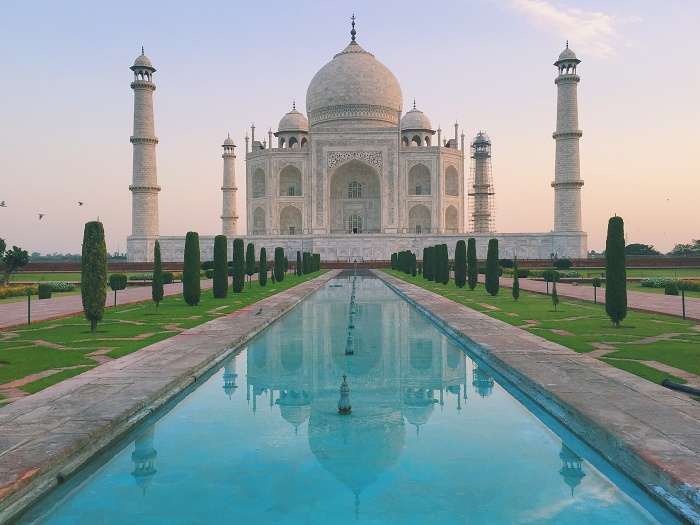
Famous as one of the wonders of the world, the Taj Mahal at Agra, India, is epitome of true love and passion. The Taj Mahal was built by the famous Mughal emperor Shah Jahan in memory of his beloved wife, Mumtaj Mahal. The architectural beauty and magnificence of the Taj Mahal has never been surpassed. It is said to be the most beautiful monument built by the Mughal rulers and represents the zenith of the Mughal architecture. Built entirely out of white marbles, the beauty of the Taj Mahal is beyond description. The beauty of the Taj Mahal has been aptly summarized by the famous English poet, Sir Edwin Arnold, as "Not a piece of architecture, as other buildings are, but the proud passions of an emperor's love wrought in living stones."
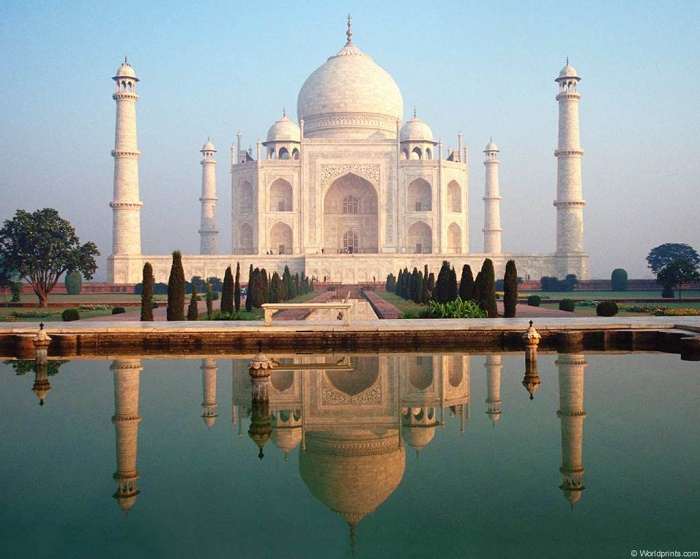
Image Credit: fantasyarts.net
Architecture and Design
Taj Mahal, synonymous with India’s identity, is the crowning jewel of Mughal architecture in India. The Mughal tradition of erecting majestic mausoleums in memory of Royal members found its culmination in the Taj’s majestic form. The Humayun’s tomb built in 1562 was a major influence over Taj’s design. An architectural marvel, the structure incorporates elements of Persian influences like the design of the Dome and incorporation of arched entrances or ‘Iwans’ along with inspiration from contemporary Hindu design elements like chhatris and copious incorporation of the lotus motif. Described by Tagore as “the tear-drop on the cheek of time”, the monument embodies funereal austerity turned into the most beautiful reminder of eternal love.
Taj Mahal is part of an elaborate complex consisting of a decorative gateway, a beautifully designed garden, a wonderful water system and a mosque. The complex is situated on the southern banks of river Yamuna. The complex stretches in a south to north incline towards the river and is constructed in steps.
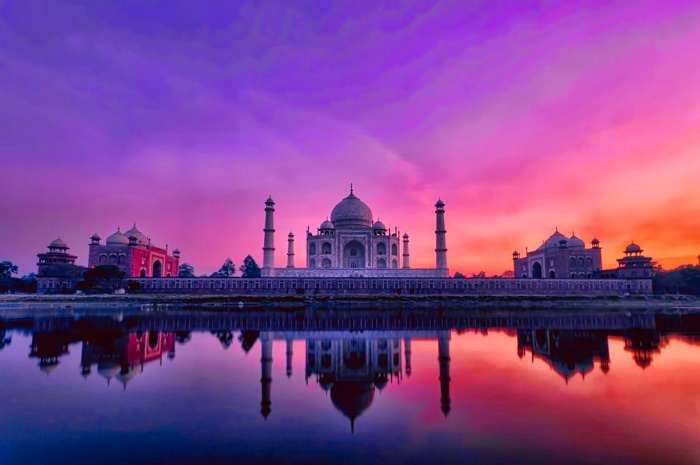
Exterior of the Taj Mahal
The central focus of the complex is the Tomb structure. Made completely out of white marble, its beauty lies in the symmetry of its architecture. The structure is situated on a raised square plinth, also made of white marble, at a height of 50 m from the river level, at one end of the complex. The tomb itself is situated at the center of the plinth, framed by four equidistant minarets. The Taj Mahal is a square structure with sides measuring 55 m. The minarets are spread at a distance of 41.75 m from the tomb wall and have a height of 39.62 m. There is a bulbous central dome in the main building, 18.28 m in diameter and 73 m in height. The dome is elevated from the top of the building by a 7 m high cylindrical base. It is decorated at its top by lotus motif and ends in a gilded finial topped with the Islamic half-moon. The spherical and grand aspect of the central dome is emphasized by incorporation of smaller domes on both sides in the form of chhatris, also capped in gilded finials. Each minaret is divided into three equal segments by two balconies and has an octagonal base. The delicate curve of the dome is emphasized by the tapering structure and slightly angular placement of the minarets. The entrance to the main tomb is framed by a huge arched vault or Iwan which in turn is again framed by two similar but smaller arches on each side. These arches indicate stacked balconies along two different levels. This is called pishtaqs, which is replicated on all the eight edges of the building affording it another dimension of symmetry.
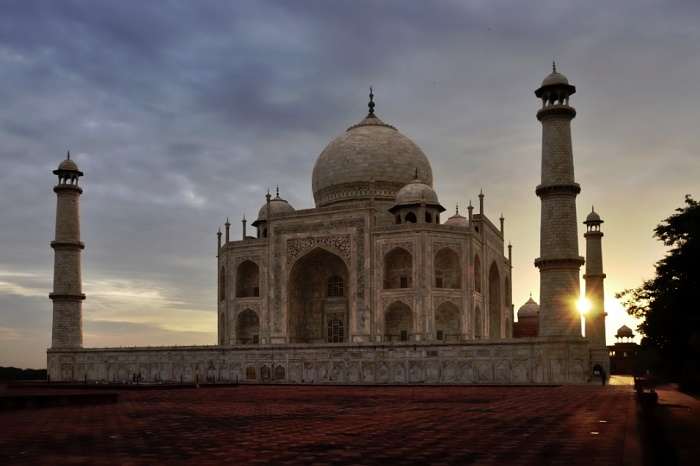
Image Credit: thecrazyfacts.com
The juxtaposition of solids and voids in combination with concave and convex design elements create a breathtaking effect of contrast. The marble exterior changes color periodically reflecting the light conditions of the day and produces an astonishing pearly diaphanous effect at night.
The exteriors of the Taj are inlaid with intricate decorations. Generously inlaid with precious gemstones like opals, lapis lazuli and jade, the decorations offer stunning flashes of color against a white background. Stucco and paintings cover the exterior walls along with calligraphy of verses from Quran or excerpts from poems in black marble. Murals of herringbone inlays and marble jaalis, mosaics of colored stones in geometric patterns along with abstract tessellations cover the exterior floors and surfaces.
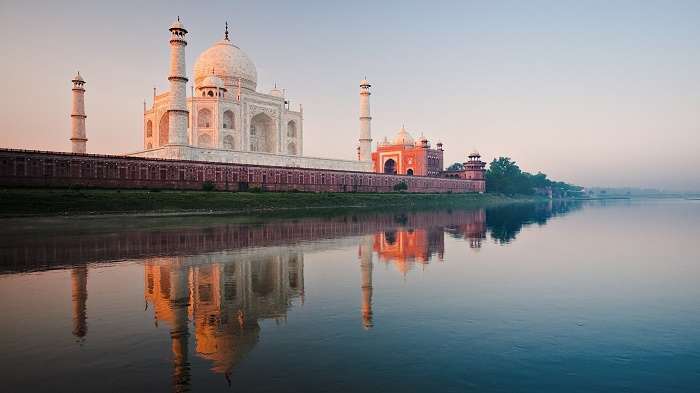
Image Credit: wallpaperscraft.com
Interior of the Taj Mahal
The interior of Taj mahal is dominated by a cavernous octagonal central chamber with eight smaller chambers radiating from it. The smaller chambers are leveled across two floors making a total of 16 such niches. The central chamber is the main funerary chamber housing the cenotaphs of Mumtaz Mahal and Shah Jahan. The two ornate marble cenotaphs are enclosed within a marble screen and face the south. The actual sarcophagi are housed below the tomb is a relatively simple crypt.
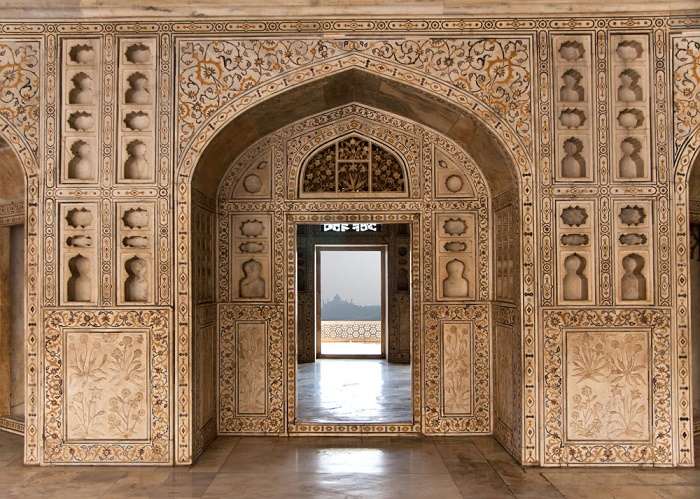
Image Credit: inspirationseek.com
Although Islam prohibits elaborate decoration of tombs, Shah Jahan flamboyantly overlooked the dictate and commissioned opulent detailing of the interior surfaces. Inlays of Pietra dura and lapidary adorn the floors and works of the walls and floors. Copious amounts of gemstones were used for the design along with colored stones. Highly polished surfaces reflect the light filtered through marble lattice work in the windows and arches. Calligraphic inscriptions of the 99 names of God is carved on the tombs itself and on Shah Jahan’s tomb an addition passage has been inscribed in impeccable calligraphy reading "He travelled from this world to the banquet-hall of Eternity on the night of the twenty-sixth of the month of Rajab, in the year 1076 Hijri.".
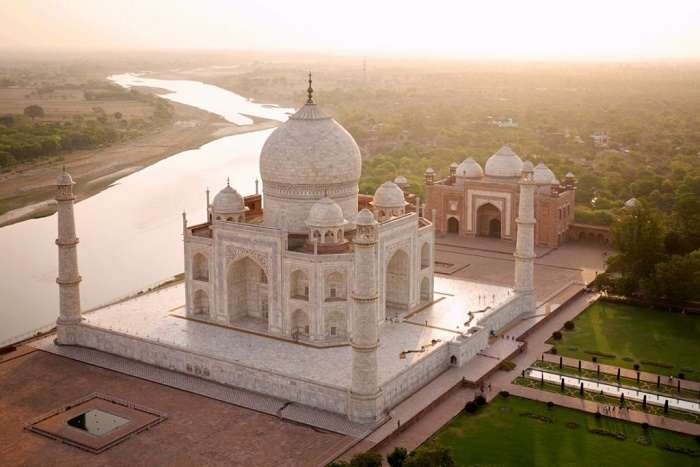
The Garden (Mughal Garden) at the Taj Mahal
The garden is an intricate part of Mughal mausoleums and is commonly known as Charbagh. Raised red sandstone pathways divide the Mughal garden into four segments which are in turn fractioned into 16 symmetrical sections. A raised square marble pool is situated midway between the Taj Mahal and the Entrance. The Hawd al-Kawthar or Tank of Abundance positioned on the north-south axis offer beautiful reflection of the Taj in all its glory. Various fruit bearing trees and Cyprus trees symbolizing life and death respectively are arranged in symmetrical equidistant patterns along the raised central pathway. The garden is designed in such a way that it offers unhindered view of the Taj from any random point.
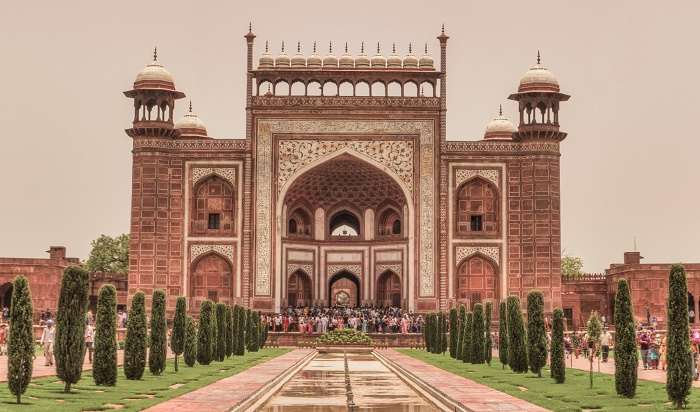
Image Credit: http://anubhavtyagi.com/wp-content/uploads/2011/07/exeperience-.jpg
Other Buildings in the Taj Complex
Every element of the Taj complex was designed to uphold the majesty and beauty of the Taj Mahal. The main entrance gateway or Darwaza-e-Rauza is constructed with red sandstone and is designed in such a way that standing outside the archway one cannot see the Taj, but upon entering it manifests offering a breathtaking effect.
The mosque on the western side of the Taj Mahal and the Nakkar Khana or guest house on the eastern side are made with red sandstone. They are mirror images of each other in design, which in Mughal architectural terms is called Jawab, and enhance the symmetry of the Taj along with emphasizing the translucent beauty of the white marble structure.
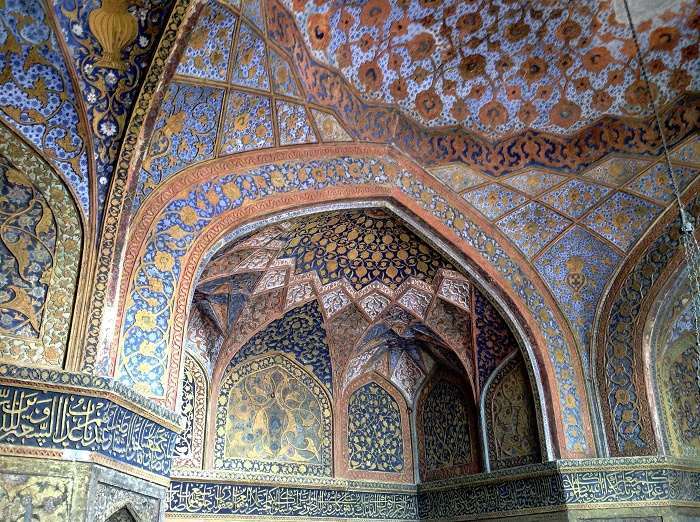
Image Credit: topworldresort.com
Construction of the Taj Mahal
Construction of the Taj Mahal started in the year 1632. Around 22,000 masons, stonecutters, calligraphers and artisans, from all over India and Central Asia were employed during the construction period of 22 years. The marble used for the building was sourced from various parts of India and around 1000 elements were employed for this purpose. A board of architects oversaw the design elements under imperial supervision. The main tomb took 10 years to build and other ancillary buildings took another 12 years to complete.
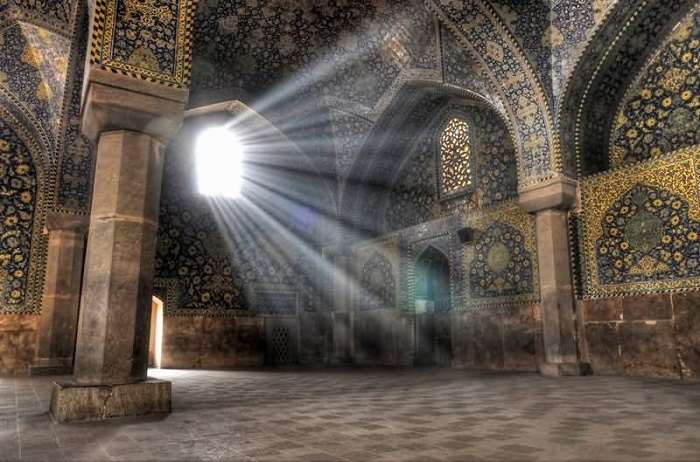
Image Credit: askideas.com
Taj Mahal - Myths & Legends
Several myths surround the Taj Mahal. The most wide spread of them is that after completion of construction, Shah Jahan ordered the thumbs of the architects and workers to be cut of so that they cannot reproduce the work they did for him. This however does not have any historical evidence.
There is also the myth of Shah Jahan commissioning a Black Taj Mahal, but was unable to finish it since his rule was overthrown by his son Aurangzeb. Some historians believe that the ruins excavated in the Mehtab Bagh, situated on the opposite bank of river Yamuna, are the incomplete remains of the structure owing to its similarity with Taj Mahal’s symmetrical architecture.
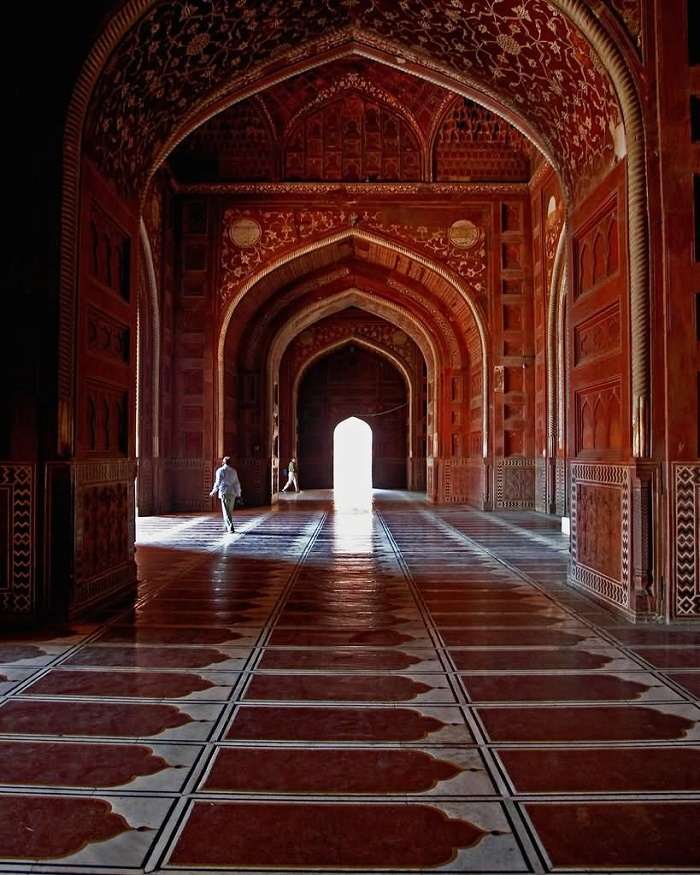
Image Credit: askideas.com
An Indian writer, P. N. Oak claimed that the Taj Mahal was built on the site of a Shiv Temple called Tejo Mahalaya that was originally built by a Hindu king Parmar Dev. However, this claim was dismissed by the Supreme Court of India despite petitions for excavations.
Last eight years of Shah Jahan was spent in confinement in the Shah Burj of the Agra Fort. It is said that he spent his days gazing towards the Taj Mahal from a small jharokha in his cell and remembering his beloved Mumtaz Mahal.



